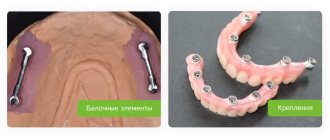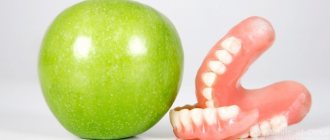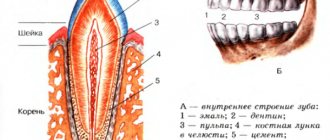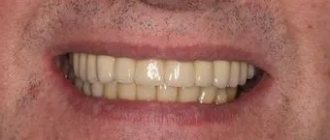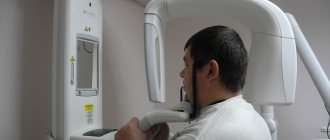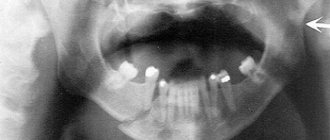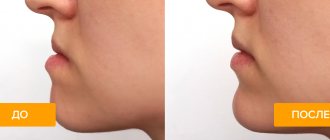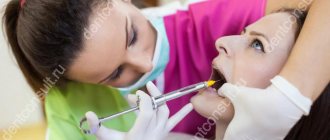A physiologically correct bite is the basis of not only a beautiful smile, but also the quality of the general condition of the entire body. Bite deviations can and should be dealt with regardless of the severity of the defect. Modern orthodontics can cope with any pathologies.
The Herbst appliance is a fixed orthodontic structure designed to correct distal occlusion (when the upper jaw is significantly larger than the lower jaw). Its use can be either an independent method of treatment or an additional means of correction.
Design features of the Herbst apparatus
As you know, distal occlusion is one of the most difficult to treat. This is due to deviations in the development of the entire jaw apparatus, and not just a violation of the position of the dental units.
The Herbst apparatus is made from individual casts of the patient’s jaw from titanium alloys and inert steel.
The design contains:
- two beams (telescopic, articulated, not hindering the natural movements of the jaws);
- four support crowns;
- metal rings for attaching beams to crowns.
How is orthodontic treatment performed with the Herbst appliance?
Orthodontic treatment using the Herbst apparatus includes several stages. First, braces are installed on the teeth, and the shape of the dentition is normalized. Both external braces and internal braces can be used. After creating the correct shape of the dentition (about six months after installing braces), they begin to correct the distal bite using the Herbst apparatus.
Braces remain on the teeth. Special crowns are installed on the two upper and four lower chewing teeth.
With internal braces it looks like this:
Telescopic hinges are attached to the crowns. The Herbst appliance constantly holds the lower jaw forward and does not interfere with mouth opening and chewing.
Gradually, the work of the muscles and temporal joints is rebuilt, and the new position of the lower jaw is fixed.
Commentary by orthodontist O.A. Baranova: “Since when correcting a distal bite, a significant restructuring of the muscles occurs and the position of the lower jaw changes, I advise my patients to undergo a course of treatment from an osteopath, who will help the body adapt to new changes. With the participation of an osteopath, bite correction is easier, faster, and there are fewer relapses. The participation of a myofunctional therapist is very important, who selects a set of exercises for additional training of the muscles that hold the lower jaw. The participation of an ENT specialist is often required so that a person constantly breathes through his nose and closes his mouth, that is, constantly puts the lower jaw in the correct position. That is why Dial-Dent implements the concept of complex treatment. In the treatment of orthodontic patients, not only an orthodontist is involved, but also an osteopath, an ENT specialist, and a myofunctional therapist. After the treatment is completed, dental prosthetics or artistic restoration are performed, that is, the patient receives an ideal smile, and not just straight teeth.”
Operating principle of the Herbst apparatus
A non-removable orthopedic design is a very active device in its effects.
This effect is possible thanks to its operating principle:
- round-the-clock operation of the device on the patient’s jaw;
- the principle of forced constant pressure on the ligaments and muscles of the dentofacial apparatus, allowing the correct position of the lower jaw to be taken and the growth of the upper jaw to be restrained.
Duration of treatment period
Changes in the patient's appearance occur in the first days after the installation of an orthodontic device.
It takes 4-12 months for the functioning of the joints, ligaments and muscles of the dentofacial apparatus to change. The duration of the treatment period depends solely on the age of the patient and the degree of complexity of the pathology.
Clinical and laboratory stages
After preparation and diagnosis, an anatomical cast is taken using standard spoons, assessed by a doctor and sent to the laboratory.
In the laboratory, a model is cast from an anatomical cast and an individual spoon is made on this model and sent to the clinic.
The doctor places an individual spoon in the mouth. In this case, the doctor performs Herbst tests (Figure 1)
on the upper jaw :
- Wide opening of the mouth - if the spoon moves, then it is necessary to shorten it from the zygomatic process to the maxillary tubercle (Fig. -1-b- (2))
- Suction of the necks - if the spoon moves, then it is necessary to shorten the edge of the spoon in the area of the cheek folds (Fig. 1-b (3))
- Pulling out the lips - if the spoon is thrown away, then you need to shorten its edge in the anterior section (Fig. 1-b(4)).
on the lower jaw :
- The patient swallows saliva - if the spoon is thrown off, then it is necessary to shorten the edge of the spoon from the place behind the tubercle to the mylohyoid line (Fig. 1-a-(1)).
- Slowly open the mouth - if the spoon is dropped, then it is necessary to shorten it in the area from the tubercles to the place of the future second molars (Fig. 1-a-(2). If the spoon rises with the front part, then it is necessary to shorten the edge of the spoon between the fangs (Fig. 1- a-(3)).
- The patient runs his tongue along the red border of his lips; if the spoon is dropped, then it is necessary to shorten the edge of the spoon, which runs along the maxillary-hyoid line (Fig. 1-a-(4)).
- With your mouth half-closed, touch your neck with the tip of your tongue. The mouth should be half closed. If the spoon moves, then you need to grind it on the hyoid edge of the spoon, moving 1 cm from the midline (Fig. 1-a-(5)).
- Touch the tip of your tongue to the tip of your nose. If the spoon moves, then it must be corrected in the area of the frenulum.
- Pull the lip forward - if the spoon moves, then you need to sharpen it again from fang to fang.
After carrying out Herbst tests, an impression is taken, which is called functional. When taking an impression, it is recommended to edge the edges of the impression to create compression.
Preparatory stage for installation of the Herbst apparatus
The complexity of the design requires special preparation of the patient for the installation procedure of the device.
To do this you will need:
- diagnose malocclusion using a comprehensive examination, including taking impressions, radiography, orthopantomogram, etc.;
- complete sanitation of the oral cavity (treatment of caries and inflammatory processes of the mucous membrane, professional hygienic teeth cleaning);
- preparation of upper molars and lower premolars for installation of supporting crowns on them;
- in the case of installing the structure on braces, telescopic beams are attached to their orthodontic arch using special centers;
- the final stage of installation consists of correction and adjustment of the telescopic mechanism.
Impression taking technique
Custom impression trays are created by a podiatrist in the dental office. The impressions obtained after the functional test are clearly aligned with the prosthetic fields. The product is pre-fitted.
Correction of the frenulum of the tongue, cheeks and lower lip is performed. Recesses are formed along the edges of the product. Depending on the location and size, the tubercles on the mucous membrane are closed completely or partially.
It is necessary to block the false mylohyoid lines and preserve the function of saliva drainage by Wharton's ducts.
During the manufacturing process of prosthetic products for edentulous jaws, potential changes in the structure of the gums are taken into account. To achieve reliable stabilization and fixation of orthopedic structures, it is necessary to obtain a clear image of the relief of the mucous membrane of the prosthetic bed. When making a dental tray for patients with edentia, the functional state of the soft tissues of the prosthetic field is taken into account.
When creating a prosthesis for toothless jaws, the tray is used as the base layer of the impression. Using corrective material of low viscosity, the doctor reliably recreates the relief of the mucous membrane.
Herbst tests are ineffective in cases of severe atrophy of the alveolar process. This is due to the fact that the methodology is standardized.
The material used to mark the boundaries of the print is plaster or silicone. Some dentists prefer silicone due to its plasticity.
Advantages and disadvantages of the Herbst apparatus
Despite the variety of types of modern orthodontic structures, the Herbst apparatus has a number of advantages that make it possible to successfully eliminate the most complex malocclusion pathologies.
These include:
- simplicity and reliability of design;
- high performance;
- due to the constant impact on the jaw, the therapeutic period of treatment is reduced;
- the adaptation period is practically absent;
- treatment of distal occlusion with the Herbst apparatus for children under 16-17 years of age, in some cases even replaces surgical intervention;
- the possibility of combining treatment with other devices and techniques;
- the enamel of multiple units of the dentition is not damaged;
- the design does not cause discomfort to its owner.
A few disadvantages include:
- quite large size of the device;
- low aesthetics;
- quite labor-intensive hygiene procedures.
Advantages of using the Herbst appliance in the treatment of distal occlusion
- The ability to accurately predict the result of orthodontic treatment using the device.
- Speed of treatment, because The device acts on the dental system constantly - 24/7.
- The device is hidden in the oral cavity, because installed on distant teeth.
- The device does not interfere with talking, smiling, or eating.
- The device is relatively small, has a smooth shape, the pistons repeat all articulatory movements, so it is relatively easy for the patient to get used to it.
- Serious damage is practically excluded.
- The Herbst apparatus can be used either independently or together with braces.
- The device has a therapeutic effect in case of breathing disorders - mouth and difficulty breathing.
- The Herbst apparatus can be installed even if there are problems with enamel.
- The device does not create any special obstacles to hygiene.
- The device can replace the surgical stage of treatment.
What awaits the patient during treatment using the Gebst apparatus?
The entire treatment plan for a particular patient is created step by step by the orthodontist when drawing up the orthodontic treatment plan, after the patient has undergone orthodontic diagnostics. This treatment plan is discussed with the patient and finalized before orthodontic treatment begins. Therefore, our patients fully understand what awaits them during treatment and at what stage this or that additional orthodontic equipment, including the Herbst apparatus, will be used.
The treatment of each patient is absolutely unique, but if we talk about the general, most commonly used scheme, then orthodontic treatment of a distal bite using the Herbst apparatus will look like this.
- Preparatory stage
. This stage includes:
- Sanitation of the oral cavity, i.e. treatment of teeth and gums if necessary. Particular attention will be paid to the supporting teeth, on which additional apparatus will be installed in the future.
- Professional oral hygiene is mandatory before starting any orthodontic treatment.
- Surgical preparation, if necessary, namely frenuloplasty and/or deepening of the oral vestibule.
- Fixation of braces
. The patient must undergo the 1st stage of orthodontic treatment, during which the teeth are aligned and the harmonious and correct shape of the dental arches of the upper and lower jaw is achieved. This means that all teeth must take their place. - Installation of the Herbst apparatus
. This stage corresponds to the 2nd stage of orthodontic treatment, during which a deep restructuring of the dental system occurs. This stage, in fact, is the stage of correcting the bite. The required time to wear the Herbst apparatus is from 3 to 10-12 months, after which the device is removed. - Continuation of orthodontic treatment with braces
. At this stage, the final correction is carried out and tight interdental contacts will be established. For this purpose, they often use orthodontic traction bands - elastics. - Retention period
is the period of retention of the result of orthodontic treatment. If the Herbst apparatus was used during treatment, the retention period will have some features: - It is MANDATORY to install a permanent retainer.
- It is advisable to combine the presence of a non-removable retainer with the wearing of a removable retention device - a removable splint-elastic positioner.
- The recommended duration of the retention period is at least 2 years.
Recommendations for patients undergoing treatment of distal occlusion using the Herbst apparatus.
We have formulated several simple rules that will make life easier for patients with the Herbst apparatus.
- The patient can brush his teeth as usual - the rules of oral care are the same as for any orthodontic treatment. Additionally, it is necessary to more thoroughly clean the distant teeth on which the device and the structure itself are attached. You may need to visit your hygienist more frequently for professional hygiene while your device is being treated.
- Patients with the Herbst apparatus do not need to completely change their diet - the apparatus does not become clogged with food, but it is advisable to exclude very hard and too sticky foods.
- Do not put too much force on the device - it is not designed for this and may break.
- Monitor the integrity of the structure of the device, inspect it regularly and carefully. The patient should be alerted to loose parts or bent of some element. If such defects are detected, you should contact your orthodontist as soon as possible, because the device may malfunction and you will not be able to move your jaw. Particularly dangerous is the breakdown of telescopic parts, which can injure the oral cavity and larynx.
Retention period after treatment with the Herbst apparatus
The final retention period is no less important than the therapeutic period. Since the non-removable Herbst appliance, as a rule, copes with complex cases of occlusion, retention takes longer than usual (about two years).
After the active influence of the orthodontic structure on the patient’s dental apparatus, his ligaments and muscles, it is important to qualitatively consolidate the functional changes in the new bite.
It is recommended to use retention products about 20 - 22 hours a day, so it is better to choose permanent type retainers.
Final correction of the bite after removal of the Herbst appliance
After removing the Herbst appliance, the orthodontist usually prescribes wearing orthodontic elastics to achieve more correct and dense interdental contacts.
The myofunctional therapist selects a set of exercises aimed at strengthening the correct functioning of the masticatory muscles and maintaining the lower jaw in a new position.
Commentary by myofunctional therapist T.B. Zukor: “When I prescribe exercises to adult patients, I often hear that there is not enough time to complete them. But the stability of a corrected bite depends on proper muscle function! Nobody wants their teeth to become crooked again, and their jaw to go back, because so much effort has been spent. The exercises are not complicated and do not require special sportswear, location or preparation. Do exercises while driving, standing in a traffic jam, when taking a shower, watching TV - any 5-10 minutes will make a significant contribution to your health!”
Throughout the entire orthodontic treatment, the osteopath relieves excess tension in the muscles and joints and helps to quickly adapt to the new bite.
Aesthetic correction after orthodontic treatment
Since the front teeth were disproportionate in size, at the end of the orthodontic treatment, Dial-Dent restored the front tooth with light-curing material Estelite Sigma Quick (Japan). The dentist who performed the restoration of the front tooth is T.I. Matienko.
At a consultation with an orthodontist
At the consultation, orthodontist Baranova O.A. made a diagnosis: crowding in the anterior part of the upper dentition, narrowing and shortening of the upper dentition, deep incisal occlusion (deep bite), distal occlusion (the lower jaw is strongly pushed back relative to the upper), linguoocclusion in the area of 37, 47.
Orthodontic treatment can correct these problems and make the teeth straighter and the profile more harmonious by increasing the lower third of the face by correcting the bite.
Various braces can be used to straighten teeth.
The patient was told about the features of various braces, the approximate duration of orthodontic treatment and cost.
To correct a deep distal skeletal bite, braces are not enough. It is necessary to change the position of the lower jaw. This can be done in several ways:
- through surgery;
- using neuromuscular technologies;
- using the Herbst apparatus .
In this case, bite correction with the Herbst apparatus .
Impression from the lower jaw
The functional impression takes place in 6 stages:
- The first test is accompanied by installation of the workpiece on the lower jaw. After this, the patient covers his mouth and swallows saliva. During this manipulation, the muscles that compress the pharynx contract. Dropping of the spoon is accompanied by its distal shortening.
- At the second stage, the patient rests his tongue first on the left cheek, and then on the right. When dropping the workpiece, you need to shorten it near the internal oblique lines.
- The third test is performed by touching the corners of the mouth with the patient’s tongue. When the spoon is displaced, it decreases in zones 3, 4 and 5 on the oral side.
- When performing the fourth stage, patients stick out their tongue and try to reach their nose. After this, the tongue is passed along the upper lip. During these manipulations, tension occurs in the chin muscles. If the spoon is displaced, it must be shortened on the front teeth on the side of the mouth.
- The anatomical impression in the fifth test is determined by the tension of the pterygomaxillary muscles when the mouth is wide open. The device is shortened distally.
- The sixth test is used to highlight the vestibular border of the product. The patient retracts his cheeks and when it is displaced, shortening is performed in the area of 6, 7 and 8 teeth. Next, the patient stretches out his lips with a tube. Tension of the chin muscles helps to release the spoon, after which it is done in the appropriate area.
Impression from the upper jaw
The procedure consists of 4 stages, according to modern classifications of individual impressions through functional tests. The first test consists of placing spoons on the upper jaw. For this purpose, the patient opens the oral cavity wide. Due to the displacement of the product, it is shortened behind the modular tubercle.
During the second test, the patient sucks in his cheeks. The shedding of the buccal cords is accompanied by a decrease in the size of the spoon around the 6th, 7th and 8th teeth, where the area of the buccal muscles is located.
At the third stage, the upper lip is pulled down and forward. Due to the displacement of the spoon, it is shortened near the 3rd, 4th and 5th teeth.
During the fourth individual test, the patient stretches out his lips with a tube. After displacement, they shorten near the 12 teeth near the incisor muscles.
Functional tests according to Herbst are considered complete if there are no displacements. Fitting is carried out using gentle movements to avoid significant reductions in the boundaries of the base.
Preparation for orthodontic treatment
After agreeing to undergo orthodontic treatment, impressions were taken, the necessary measurements, examinations, and consultations with other specialists were carried out. As part of the Dental promotion, the patient received professional teeth cleaning using the Air Flow method as a gift.
Before starting orthodontic treatment, it was necessary to cure caries.
The patient was able to undergo treatment for dental caries at the Dental Center. The presence of the necessary specialists in one clinic makes the process of orthodontic treatment more comfortable.
After preparing the teeth and all the calculations, Damon-Q braces were fixed on the teeth.
